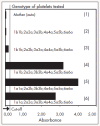A case report of neonatal alloimmune thrombocytopenic purpura: the importance of correct diagnosis for future pregnancies
- PMID: 16389419
- PMCID: PMC11060405
- DOI: 10.1590/s1516-31802005000400008
A case report of neonatal alloimmune thrombocytopenic purpura: the importance of correct diagnosis for future pregnancies
Abstract
Context: Neonatal alloimmune thrombocytopenic purpura (NAITP) is a neonatal disorder characterized by maternal alloimmunization against fetal platelet antigens inherited from the father. Intracranial hemorrhage leading to death or permanent neurological disability may occur in the fetus.
Case report: A healthy 30-year-old woman gave birth to her first baby by cesarean after an uneventful 36-week pregnancy. Ten hours after birth, the infant presented severe petechiae, with platelet count of 8 x 10(3)/microl. The mother's platelet count was normal (180 x 10(3)/microl). The infant re ceived intravenous immunoglobulin and was discharged 18 days later, with platelet count of 100 x 10(3)/microl. The cause of thrombocytopenia was not elucidated at that time. One year later, the infant died of neuroblastoma. Since the parents wanted another child, they were referred for investigation of this thrombocytopenia. Platelet genotyping and platelet antibody screening were performed, showing total HPA-1 system mismatch between mother (HPA-1b1b) and father (HPA-1a1a), with anti-HPA-1a antibodies in the mother's serum. We concluded that the first baby was born with NAITP. Thus, in the second pregnancy, the mother was treated with several infusions of intravenous immunoglobulin. Careful ultrasound monitoring was performed, with normal results for mother and fetus throughout the pregnancy. The second baby was born by cesarean at 39 weeks, presenting 92 x 10(3) platelets/microl six hours after birth. The baby's platelets were genotyped as HPA-1a1b and the mother's serum again showed anti-HPA-1a antibodies. No clinical bleeding was observed. Intravenous immunoglobulin therapy was an effective treatment for preventing NAITP in the second baby.
CONTEXTO:: Púrpura trombocitopênica neonatal aloimune (PTNA) é uma doença neonatal caracterizada por aloimunização materna contra as plaquetas fetais, que apresentam antígenos herdados do pai. Podem ocorrer hemorragias cerebrais, levando à morte ou a anomalias neurológicas permanentes.
RELATO DE CASO:: Mulher saudável, de 30 anos, deu à luz, por parto cesariano na 36a semana de gestação, seu primeiro filho. Com 10 horas de vida, o recém-nascido apresentou petéquias e contagem de 8 × 103 plaquetas/µl no sangue periférico; foi medicado com imunoglobulina e recebeu alta após 18 dias de internação, com 100 × 103 plaquetas/µl. A causa da trombocitopenia não foi elucidada na época. Um ano depois, a criança morreu de neuroblastoma. Como os pais desejavam outro filho, foram encaminhados para investigação da trombocitopenia. Genotipagem plaquetária e pesquisa de anticorpos antiplaquetários foram realizadas, mostrando total falta de concordância entre os sistemas HPA-1 do pai (HPA-1a1a) e da mãe (HPA-1b1b) e anticorpos anti-HPA-1a no soro da mãe. Concluímos que o primeiro bebê nasceu com PTNA. Por isso, na segunda gravidez, a mãe foi tratada com diversas infusões de imunoglobulina intravenosa. Foi realizado cuidadoso monitoramento por ultra-som, com resultados normais para mãe e feto durante a gravidez. O segundo bebê nasceu por cesárea às 39 semanas, apresentando 92 × 103 plaquetas/µl seis horas após o nascimento. As plaquetas do recém-nascido foram genotipadas como HPA-1a1b e o soro da mãe novamente mostrou anticorpos anti-HPA-1a. Não houve hemorragia. A terapia de infusão de imunoglobulina foi efetiva na prevenção da PTNA no segundo filho.
Conflict of interest statement
Figures


References
-
- Forestier F, Hohlfeld P. Management of fetal and neonatal alloimmune thrombocytopenia. Biol Neonate. 1998;74(6):395–401. - PubMed
-
- Engelfriet CP, Reesink HW, Kroll H, et al. Prenatal management of alloimmune thrombocytopenia of the fetus. Vox Sang. 2003;84(2):142–149. - PubMed
-
- Goldman M, Trudel E, Richard L. Report on the Eleventh International Society of Blood Transfusion Platelet Genotyping and Serology Workshop. Vox Sang. 2003;85(2):149–155. - PubMed
-
- Meyer O, Hildebrandt M, Schulz B, Blasczyk R, Salama A. Simultaneous genotyping of human platelet antigens (HPA) 1 through 6 using new sequence-specific primers for HPA-5. Transfusion. 1999;39(11-12):1256–1258. - PubMed
-
- Kaplan C. Immune thrombocytopenia in the foetus and the newborn: diagnosis and therapy. Transfus Clin Biol. 2001;8(3):311–314. - PubMed

